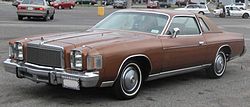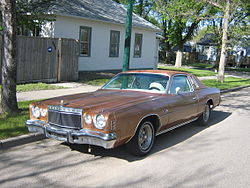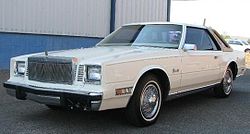- Chrysler Cordoba
-
Chrysler Cordoba  1978-1979 Chrysler Cordoba
1978-1979 Chrysler CordobaManufacturer Chrysler Corporation Production 1975–1983 Assembly Windsor, Ontario, Canada Class Personal luxury car Body style 2-door coupe Layout FR layout Transmission 3-speed automatic The Chrysler Cordoba was an intermediate personal luxury coupe sold by Chrysler Corporation in North America from 1975-1983. It was the company's first model produced specifically for the personal luxury market and the first Chrysler-branded vehicle that was less than full-size.
Contents
History
In the early 1960s, when other upmarket brands were expanding into smaller cars with such models as the Mercury Comet and Buick Skylark, Chrysler very publicly declared that there would "never" be a smaller Chrysler.
The Cordoba name was used in 1970 on a special version of a Chrysler Newport hardtop (two-door and four-door).[1] This full-size model was a "limited edition luxury car, designed to introduce you to Chrysler" and consisted of an exclusive "Cordoba Gold" paint with matching wheels, wheel covers, and side molding with vinyl inserts.[1] Chrysler described this model's textured antique gold all-vinyl interior, matching vinyl roof cover, and the hood ornament with an Aztec eagle as "quiet Spanish motif".[1] Included in the US$4,241.65 price was the 383 cu in (6.28 L) 290 bhp (220 kW) two-barrel carburetor V8 engine, automatic transmission, power steering, H78x15 fiberglass-belted whitewall tires, and a "golden tone" AM radio.[1]
The smaller Cordoba was introduced in 1975, as a contender in the personal luxury market that was powered by smaller, more economical engines than other Chryslers, and riding on a 115 in (2,900 mm) wheelbase, 9 in (230 mm) less than the traditional models at the time.[2] This single body style coupe was one of Chrysler's few genuine hits of the 1970s. At a time when the automaker was teetering on bankruptcy, demand for Cordobas actually exceeded supply for its first couple of years, with production of over 150,000 units for the inaugural 1975 models, and the most built in 1977, with 183,000 units.[2] Half of Chrysler division production during this period (and occasionally more) was composed of Cordobas, and they helped to revive the division.[2] All Cordobas were built in Windsor, Ontario.
Although Córdoba is the name of a city in Spain, the car's emblem was actually a stylized version of the Argentina cordoba coin. Either way, the implication was Hispanic, and this theme was carried out with somewhat baroque trim inside the vehicle, as well as by Chrysler famously using Mexican movie star Ricardo Montalban as the car's advertising spokesman.[3] Notable was his eloquent praise of its "soft Corinthian leather" interior[4] and his Americanized stress on the second syllable of the car's name.
First generation (1975–1979)
First generation  1975-1977 Chrysler Cordoba
1975-1977 Chrysler CordobaProduction 1975–1979 Platform B-body Engine 318 cu in (5.2 L) LA V8
360 cu in (5.9 L) LA V8
400 cu in (6.6 L) B V8Transmission 3-speed A727 automatic Wheelbase 115 in (2,900 mm) Length 215.3 in (5,470 mm) Width 77.1 in (1,960 mm) Height 52.6 in (1,340 mm) Related Chrysler 300
Dodge Charger
Dodge Magnum
Plymouth FuryThe Cordoba was introduced by Chrysler for the 1975 model year as an upscale personal luxury car. At the time, this market segment was large and growing, with the Chevrolet Monte Carlo and Pontiac Grand Prix selling over 300,000 units each annually. The car carried the Chrysler name, then still associated exclusively with large luxury models like the Imperial. It was, however, priced to compete with rivals such as the Monte Carlo, Ford Elite, and Oldsmobile Cutlass Supreme. The Cordoba was originally intended to be a Plymouth (the names Mirada, Premier, and Grand Era were associated with the project), but losses from the newly introduced full-size C-body models due to the 1973 oil crisis encouraged Chrysler executives to seek higher profits by marketing the model as a Chrysler, a name with a more upscale appeal. The car was a success, with over 150,000 examples sold in 1975, a sales year that was otherwise dismal for the company.
For the 1976 model year, sales increased slightly to 165,000. The mildly tweaked 1977 version also sold well, with just under 140,000 cars. The success of using the Chrysler nameplate strategy is contrasted to sales of its similar and somewhat cheaper corporate cousin, the Dodge Charger SE. The similar Dodge achieved only a quarter of Cordoba's sales during the same model years, due to the fact that the Cordoba cost only $160 more than the Charger, leading customers to spend the extra for the prestige of the Chrysler nameplate.
Interiors were somewhat more luxurious than the Dodge Charger SE and much more than the top-line standard intermediates (Plymouth Fury, Dodge Coronet) with a velour cloth notchback bench seat and folding armrest standard. Optionally available were bucket seats upholstered in Corinthian leather with a center armrest and cushion, or at extra cost, a center console with floor shifter and storage compartment. The dashboard and door panels featured simulated burled elm trim and metal stampings in 1975, while 1976-79 models featured simulated rosewood trim. A 60/40 bench seat was introduced in 1976 and other seating/upholstery options were added each year through 1979.
The original design endured with only small changes for three years before a variety of factors contributed to a decline in sales. For 1978, there was a modest restyling with the then popular rectangular headlights in a stacked configuration. This made the Cordoba look similar the 1976 to 1977 Monte Carlo from the front. A Chrysler designer, Jeffrey Godshall, wrote in Collectible Automobile magazine that this restyling was viewed as "somewhat tacky" and eliminated much of the visual appeal that the 1975 to 1977 Cordobas had been known for. The restyle also made the car appear heavier than its 1975-77 predecessor at a time when other cars in this class were being downsized to smaller dimensions such as the Ford Thunderbird in 1977 and Chevy Monte Carlo and Pontiac Grand Prix in 1978.
The Cordoba's sales decline in 1978 and 1979 could also be attributed to the introduction of the smaller Chrysler LeBaron in mid-1977 that was available in both sedan and coupe models, and offered similar personal-luxury styling and options.
At the same time, Chrysler's financial position and quality reputation was in steady decline. Rising gas prices and tightening fuel economy standards made the Cordoba's nearly 4,000 lb (1,800 kg) weight with 360 cu in (5.9 L) or 400 cu in (6.6 L) V8 engines obsolete. However, for its final year in 1979, a performance oriented version made a return in the form of a one-year-only revival of the Chrysler 300 name.
Second generation (1980–1983)
Second generation  1980 Chrysler Cordoba
1980 Chrysler CordobaProduction 1980–1983 Platform J-body Engine 225 cu in (3.7 L) Slant 6 I6
318 cu in (5.2 L) LA V8Transmission 3-speed A904 automatic Wheelbase 112.7 in (2,860 mm)[5] Length 209.8 in (5,330 mm) (1980)
210.1 in (5,340 mm) (1981)
209.6 in (5,320 mm) (LS)Width 72.7 in (1,850 mm) Height 53.3 in (1,350 mm) (1980/81)
53.2 in (1,350 mm) (1982-)Curb weight 3,446 lb (1,563 kg) (1980/81)
3,460 lb (1,569 kg) (1982)
3,467 lb (1,573 kg) (1983)
3,389 lb (1,537 kg) (LS 1981/82)
3,404 lb (1,544 kg) (LS 1983)Related Dodge Mirada
ImperialThe Cordoba was downsized for the 1980 model year. The new smaller model used the J-platform that dated back to the 1976 Plymouth Volaré and was twinned up with the newly-named but very similar Dodge Mirada. Chrysler also revived the Imperial for 1981 as a third variant of the J-platform.
The Cordoba and Mirada now had a standard six-cylinder engine (the 225 Slant Six) that, while very reliable, did not seem to be suitable power for these slightly upmarket coupes. The much-detuned 318 cu in (5.2 L) V8 was an option (standard on the Imperial), as the 360 cu in (5.9 L) V8 was dropped.[6]
The 1980 and 1981 LS model (which was originally intended to be the "300") featured an aerodynamic-appearing nosecone (nearly identical to that on the Mirada) with a "crosshair" grille. Other features of this model were the deletion of the vinyl roof cover and a monotone color exterior.
The second-generation Cordoba's styling did not attract the praise of the original, and sales were off substantially. The industry downsizing of vehicles also affected the personal luxury models. Both the Chevrolet Monte Carlo in 1978 and the 1980 Ford Thunderbird shrank in size and sales simultaneously. However, those models eventually recovered as their makers moved to correct their cars' flaws, while the smaller Cordoba never did. Chrysler was increasingly concentrating on its compact, front wheel drive models with four and six-cylinder engines, and management stopped producing the Cordoba in 1983.
Powertrains
The 360 cu in (5.9 L) V8 was discontinued after the 1980 model year.[6] Only two engines were available with the Slant-6 being standard and the 318 cu in (5.2 L) V8 optional for the 1981-83 model years.
engine displacement, type,
carburetor typemax. motive power at rpm max. torque at rpm transmission 225 cu in (3,687 cc) Slant 6 I6
1-barrel90 bhp (67 kW; 91 PS) (1980)
85 bhp (63 kW; 86 PS) (1981–83) @ 3600160 lb·ft (217 N·m) (1980)
165 lb·ft (224 N·m) (1981–83) @ 16003-speed A904 automatic 318 cu in (5,211 cc) LA V8
2-barrel120 bhp (89 kW; 122 PS) (1980)
130 bhp (97 kW; 132 PS) (1981–84) @ 3600245 lb·ft (332 N·m) (1980)
230 lb·ft (312 N·m) (1981–83) @ 1600[5] NASCAR
Both the first generation and second generation Cordobas made appearances in NASCAR. Ed Negre campaigned one occasionally in 1979-80 seasons, and Buddy Arrington ran a second generation car in the 1982-84 seasons, alternating with Dodge Miradas and Chrysler Imperials. The Cordoba was no more aerodynamic than the other Mopars and never finished higher than 15th in any race entered.
Collectibility
Chrysler's Cordoba has a fairly loyal owner base, and some models are considered collectible. Good examples include early production 1975s, particularly with the optional four-barrel carburetor. However, the second generation Cordoba has attracted little interest in the collector market. Regarding the 300 version Consumer Guide states "the '79 could become a minor collectible in the distant future, but LS prospects seem slim to non-existent at this time."[7]
References
- ^ a b c d "The new Chrysler Cordoba (advertisement)". Ebony 25 (6): 84–85. April 1970. http://books.google.com/books?id=k0SaFPIrCVkC&pg=PA85&dq=Chrysler+Cordoba+collector+car. Retrieved 2010-12-27.
- ^ a b c Hyde, Charles K. (2003). Riding the Roller Coaster: A History of the Chrysler Corporation. Wayne State University Press. p. 223. ISBN 9780814330913. http://books.google.com/books?id=aQhTq18vi7AC&pg=PA223&dq=Chrysler+Cordoba+history. Retrieved 2010-12-27.
- ^ Novas, Himilce (2008). Everything you need to know about Latino history: 2008 edition. Penguin Group. pp. 330–331. ISBN 9780452288898. http://books.google.com/books?id=zZhjWwXS2X8C&pg=PA331&dq=Montalban+Chrysler+Cordoba+history. Retrieved 2010-12-27.
- ^ Frum, David (2000). How We Got Here : The 70's--The Decade that Brought You Modern Life--For Better or Worse. Basic Books. p. 25. ISBN 978-0465041954.
- ^ a b "Chrysler Cordoba, Specifications and Dimensions". http://www.moparautos.com/cordoba81-83.htm. Retrieved 2010-11-05.
- ^ a b "1978-1980 Chrysler Cordoba". Moparautos.com. http://moparautos.com/cordoba78-80.htm. Retrieved 2010-12-27.
- ^ Auto Editors of Consumer Guide (2007-07-26). "1979-1982 Chrysler Cordoba 300/Cordoba LS". auto.howstuffworks.com. http://auto.howstuffworks.com/1979-1982-chrysler-cordoba-300-cordoba-ls.htm. Retrieved 2010-12-27.
External links
Chrysler timeline, 1970–present Type 1970s 1980s 1990s 2000s 2010s 0 1 2 3 4 5 6 7 8 9 0 1 2 3 4 5 6 7 8 9 0 1 2 3 4 5 6 7 8 9 0 1 2 3 4 5 6 7 8 9 0 1 2 Compact LeBaron PT Cruiser Town & Country Town & Country Mid-size LeBaron (2-dr) Sebring (2-dr) Sebring (2-dr) LeBaron conv. Sebring conv. Sebring conv. Sebring conv. 200 conv. E-Class LeBaron GTS LeBaron (4-dr) Cirrus Sebring (4-dr) Sebring (4-dr) 200 (4-dr) LeBaron Fifth Avenue New Yorker Full-size Newport Newport Fifth Avenue Concorde Concorde 300 300 New Yorker New Yorker New Yorker New Yorker New Yorker 300M Town & Country Imperial LHS LHS Sports Laser Conquest Prowler Crossfire Crossover SUV Pacifica SUV Aspen Minivan TEVan Voyager Voyager Town & Country Town & Country Town & Country Town & Country Town & Country Limousine Executive Personal luxury Cordoba Imperial GT TC See also: List of Chrysler vehicles Categories:- Chrysler vehicles
- Luxury vehicles
- Mid-size cars
- Rear wheel drive vehicles
- Coupes
- 1970s automobiles
- 1980s automobiles
- Vehicles introduced in 1975
Wikimedia Foundation. 2010.


